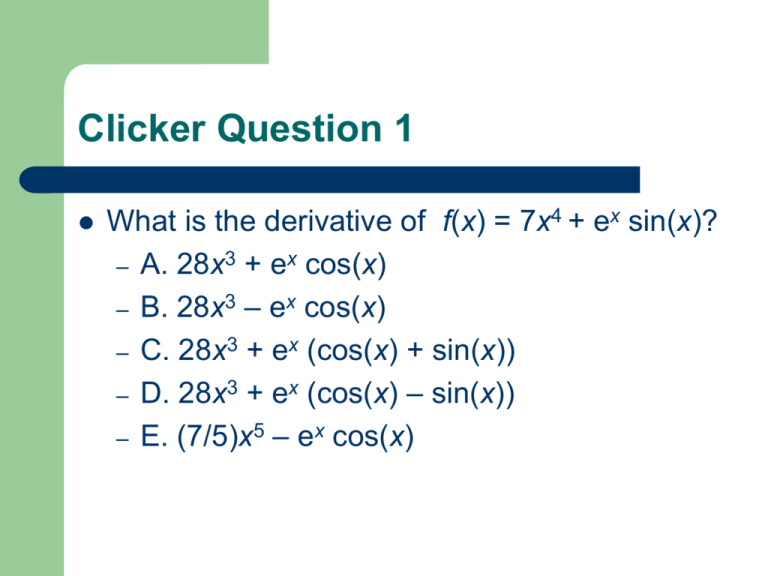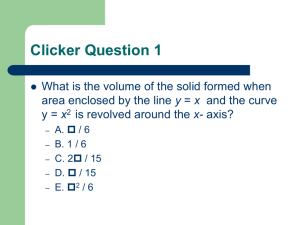Document
advertisement

Clicker Question 1 What is the derivative of f(x) = 7x4 + ex sin(x)? – A. 28x3 + ex cos(x) – B. 28x3 – ex cos(x) – C. 28x3 + ex (cos(x) + sin(x)) – D. 28x3 + ex (cos(x) – sin(x)) – E. (7/5)x5 – ex cos(x) Clicker Question 2 What is the derivative of g(x) = tan(x2 + 5) ? – A. tan (2x) – B. sec2(2x) – C. sec2(x2 + 5) – D. 2x tan(x2 + 5) – E. 2x sec2(x2 + 5) The Fundamental Theorem (9/10/10) Given a function f(x) on an interval [a, b]: An antiderivative (or “indefinite integral”) F(x) of f(x) is a function. b f ( x)dx (the “definite integral”) is a number a (the adding-up of f 's value between a and b). The FTC tells us how to get the first from the second or the second from the first. “Techniques of Integration”, or “Techniques of Antidifferentiation” Finding derivatives involves facts and rules; it is a completely mechanical process. Finding antiderivatives is not completely mechanical. It involves some facts, a couple of rules, and then various techniques which may or may not work out. There are many functions (e.g., f(x) = ex^2) which have no known antiderivative formula. There Are a Couple of “Rules” Sum and Difference Rule: Antiderivatives can be found working term by term (just like derivatives). Constant Multiplier Rule: Constant multipliers just get carried along as you get antiderivatives (just like derivatives). HOWEVER, there is no Product Rule, Quotient Rule, or Chain Rule for Antiderivatives! Reversing the Chain Rule: “substitution” or “guess and check” Any ideas about x2(x3 + 4)5 dx ?? How about x ex^2 dx ? Try ln(x) / x dx But we’ve been lucky! Try sin(x2) dx The Substitution Technique It’s called a “technique”, not a “rule”, because it may or may not work. If there is a chunk, try calling the chunk u. Compute du = (du/dx) dx Replace all parts of the original expression with things involving u (i.e., eliminate x). If you were lucky/clever, the new expression can be anti-differentiated easily. Clicker Question 3 What is an antiderivative of f(x) = x2 cos(x3) ? – – – – – A. (1/3) sin(x3) B. (1/3)x3 sin(x3) C. sin(x3) D. (-1/3) sin(x3) E. (1/3)x3 sin((1/4)x4) Assignment for Monday Read Section 5.5 of the text and go over today’s class notes. In Section 5.5, do Exercises 1-31 odd.
![Math 131 Practice Exam 3 on [ -1, 4].](http://s2.studylib.net/store/data/010538103_1-a851ef52d08f89241a99ddd9d94bbb2a-300x300.png)






